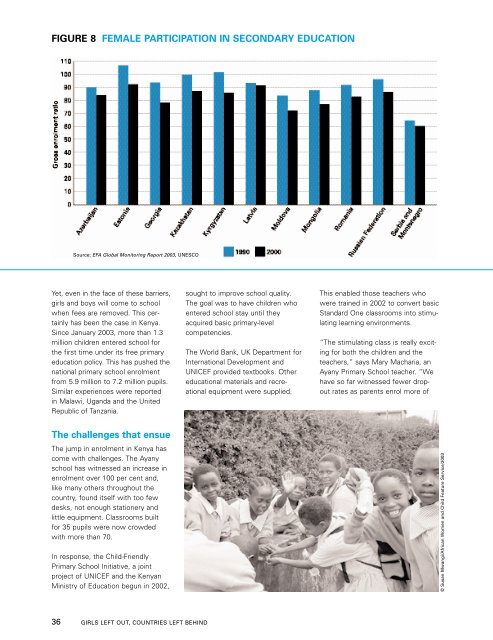THE STATE OF THE WORLD'S CHILDREN 2004 - Unicef
THE STATE OF THE WORLD'S CHILDREN 2004 - Unicef
THE STATE OF THE WORLD'S CHILDREN 2004 - Unicef
You also want an ePaper? Increase the reach of your titles
YUMPU automatically turns print PDFs into web optimized ePapers that Google loves.
FIGURE 8 FEMALE PARTICIPATION IN SECONDARY EDUCATION<br />
Source: EFA Global Monitoring Report 2003, UNESCO<br />
Yet, even in the face of these barriers,<br />
girls and boys will come to school<br />
when fees are removed. This certainly<br />
has been the case in Kenya.<br />
Since January 2003, more than 1.3<br />
million children entered school for<br />
the first time under its free primary<br />
education policy. This has pushed the<br />
national primary school enrolment<br />
from 5.9 million to 7.2 million pupils.<br />
Similar experiences were reported<br />
in Malawi, Uganda and the United<br />
Republic of Tanzania.<br />
sought to improve school quality.<br />
The goal was to have children who<br />
entered school stay until they<br />
acquired basic primary-level<br />
competencies.<br />
The World Bank, UK Department for<br />
International Development and<br />
UNICEF provided textbooks. Other<br />
educational materials and recreational<br />
equipment were supplied.<br />
This enabled those teachers who<br />
were trained in 2002 to convert basic<br />
Standard One classrooms into stimulating<br />
learning environments.<br />
“The stimulating class is really exciting<br />
for both the children and the<br />
teachers,” says Mary Macharia, an<br />
Ayany Primary School teacher. “We<br />
have so far witnessed fewer dropout<br />
rates as parents enrol more of<br />
The challenges that ensue<br />
The jump in enrolment in Kenya has<br />
come with challenges. The Ayany<br />
school has witnessed an increase in<br />
enrolment over 100 per cent and,<br />
like many others throughout the<br />
country, found itself with too few<br />
desks, not enough stationery and<br />
little equipment. Classrooms built<br />
for 35 pupils were now crowded<br />
with more than 70.<br />
In response, the Child-Friendly<br />
Primary School Initiative, a joint<br />
project of UNICEF and the Kenyan<br />
Ministry of Education begun in 2002,<br />
© Susan Mwangi/African Women and Child Feature Service/2003<br />
36 GIRLS LEFT OUT, COUNTRIES LEFT BEHIND
















